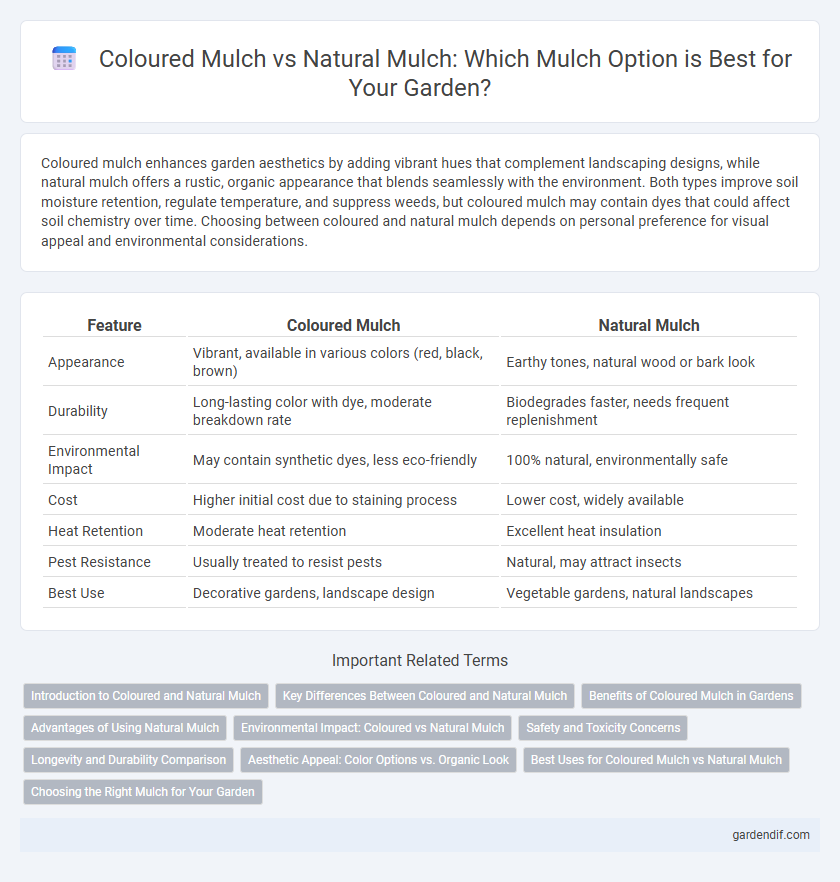
Coloured mulch vs Natural mulch Illustration
Coloured mulch enhances garden aesthetics by adding vibrant hues that complement landscaping designs, while natural mulch offers a rustic, organic appearance that blends seamlessly with the environment. Both types improve soil moisture retention, regulate temperature, and suppress weeds, but coloured mulch may contain dyes that could affect soil chemistry over time. Choosing between coloured and natural mulch depends on personal preference for visual appeal and environmental considerations.
Table of Comparison
| Feature | Coloured Mulch | Natural Mulch |
|---|---|---|
| Appearance | Vibrant, available in various colors (red, black, brown) | Earthy tones, natural wood or bark look |
| Durability | Long-lasting color with dye, moderate breakdown rate | Biodegrades faster, needs frequent replenishment |
| Environmental Impact | May contain synthetic dyes, less eco-friendly | 100% natural, environmentally safe |
| Cost | Higher initial cost due to staining process | Lower cost, widely available |
| Heat Retention | Moderate heat retention | Excellent heat insulation |
| Pest Resistance | Usually treated to resist pests | Natural, may attract insects |
| Best Use | Decorative gardens, landscape design | Vegetable gardens, natural landscapes |
Introduction to Coloured and Natural Mulch
Coloured mulch enhances garden aesthetics with vibrant hues made from dyed wood or rubber, offering long-lasting color and weed suppression. Natural mulch, derived from organic materials like bark, leaves, or straw, enriches soil fertility by decomposing and improving moisture retention. Both types protect plant roots and regulate soil temperature, but coloured mulch emphasizes visual appeal while natural mulch fosters ecological benefits.
Key Differences Between Coloured and Natural Mulch
Coloured mulch is treated with dyes that enhance the aesthetic appeal and provide uniformity in garden beds, while natural mulch consists of untreated organic materials like wood chips or bark that decompose over time, enriching the soil. Coloured mulch tends to retain color and resist fading longer but may contain additives, whereas natural mulch offers better soil aeration and moisture retention due to its organic composition. Both types serve weed control and temperature regulation, but choosing between them depends on garden design preferences and soil health priorities.
Benefits of Coloured Mulch in Gardens
Coloured mulch enhances garden aesthetics by providing vibrant, long-lasting hues that complement plant foliage and landscape designs. It helps retain soil moisture, suppress weeds, and regulate soil temperature, promoting healthier plant growth. Unlike natural mulch, coloured mulch often resists fading and decomposition, reducing the frequency of replacement and maintenance.
Advantages of Using Natural Mulch
Natural mulch enhances soil fertility by decomposing and releasing essential nutrients that promote healthy plant growth. It improves moisture retention and regulates soil temperature, reducing water evaporation and protecting roots from extreme weather. Unlike coloured mulch, natural mulch supports beneficial soil organisms, contributing to a balanced and sustainable garden ecosystem.
Environmental Impact: Coloured vs Natural Mulch
Natural mulch, made from organic materials such as wood chips or bark, decomposes over time, enriching soil health and promoting beneficial microbial activity essential for sustainable ecosystems. Coloured mulch, often treated with dyes or chemicals, may introduce contaminants into the soil, potentially harming plant growth and disrupting local biodiversity. The environmental footprint of coloured mulch includes concerns about the sourcing of dyes and reduced biodegradability, making natural mulch a more eco-friendly option for long-term garden health.
Safety and Toxicity Concerns
Coloured mulch often contains synthetic dyes and chemical additives that can pose safety and toxicity risks to pets, children, and the environment, whereas natural mulch is generally free from harmful substances. Natural mulch, such as shredded bark or wood chips, decomposes safely without releasing toxins, promoting healthier soil and plant growth. Choosing non-toxic, untreated natural mulch minimizes exposure to potentially hazardous compounds, ensuring safer landscaping practices.
Longevity and Durability Comparison
Coloured mulch typically contains added dyes that can extend its visual appeal by resisting fading longer than natural mulch, which decomposes faster due to its organic composition. Natural mulch breaks down more quickly, enriching soil nutrients and improving moisture retention but may need replacement more often to maintain appearance and effectiveness. Durability of coloured mulch is enhanced by chemical treatments, offering longer-lasting coverage and reduced need for frequent replenishment in landscaping projects.
Aesthetic Appeal: Color Options vs. Organic Look
Coloured mulch offers vibrant, long-lasting shades such as red, black, and brown, enhancing garden design with a bold, uniform appearance that complements modern landscaping. Natural mulch provides a more organic look with earthy tones and texture variations that blend seamlessly into natural environments, promoting a rustic and traditional garden aesthetic. Choosing between coloured and natural mulch depends on whether the goal is to create a striking visual impact or maintain a natural, understated garden ambiance.
Best Uses for Coloured Mulch vs Natural Mulch
Coloured mulch is ideal for enhancing landscape aesthetics, providing vibrant hues that highlight flower beds and garden borders while offering weed suppression and moisture retention. Natural mulch excels in nourishing soil health by decomposing and enriching organic matter, making it best suited for vegetable gardens and areas requiring nutrient-rich ground cover. Both types serve moisture conservation and erosion control but differ primarily in decorative impact and soil improvement benefits.
Choosing the Right Mulch for Your Garden
Coloured mulch enhances garden aesthetics by providing vibrant hues that complement plant foliage while also offering effective moisture retention and weed suppression. Natural mulch, such as bark or wood chips, enriches soil health by decomposing and adding organic matter, promoting beneficial microbial activity. Selecting the right mulch depends on prioritizing soil improvement and natural appearance versus decorative appeal and long-lasting color stability.
Coloured mulch vs Natural mulch Infographic

 gardendif.com
gardendif.com